The demand for water soluble fertilizers in Japan is valued at USD 1.1 billion in 2025 and is projected to reach USD 1.7 billion by 2035, reflecting a compound annual growth rate of 4.9%. Growth is shaped by continued use of precision application methods across horticulture, greenhouse farming and high-value crop production. Water soluble formulations offer uniform nutrient delivery and enable controlled feeding schedules through drip and foliar systems. As growers emphasize application accuracy and crop-specific blends, procurement of soluble formulations increases in line with steady agricultural activity. These factors maintain a consistent upward trend as commercial farms, nurseries and controlled-environment facilities expand nutrient management programs across the forecast window.
The growth curve displays a smooth, incremental rise beginning at USD 0.9 billion in earlier years and reaching USD 1.1 billion in 2025 before progressing toward USD 1.7 billion by 2035. Annual values advance in predictable steps, moving from USD 1.1 billion in 2026 to USD 1.2 billion in 2027 and continuing through USD 1.4 billion in 2031 and USD 1.6 billion in 2033. This pattern reflects stable adoption tied to routine fertilization programs rather than sharp swings in demand. As producers refine nutrient combinations and integrate soluble blends into automated irrigation systems, year-to-year increases remain steady. The curve underscores a mature yet gradually expanding category supported by consistent crop production needs across Japan’s agricultural landscape.
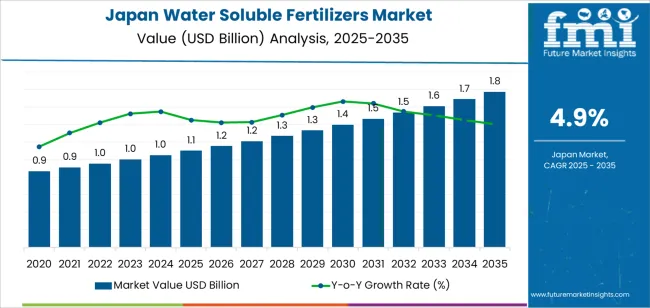
Demand in Japan for water soluble fertilizers is projected to rise from USD 1.1 billion in 2025 to USD 1.7 billion by 2035, reflecting a compound annual growth rate (CAGR) of approximately 4.9%. From USD 0.9 billion in 2020 the value climbs to about USD 1.0 billion by 2024, reaches USD 1.1 billion in 2025, and then continues upward to USD 1.3 billion by around 2030. Over the forecast period, demand then advances to USD 1.7 billion by 2035. Growth is fuelled by increasing adoption of precision agriculture practices, rising use of fertigation and foliar nutrition systems, and a growing emphasis on efficient nutrient delivery aligned with sustainability objectives.
Over the decade between 2025 and 2035 the absolute value uplift of USD 0.6 billion is comprised of both volume and value contributions. In the early years, volume growth dominates more growers adopt water soluble fertilizers and improve application efficiency. In the later half of the period, value growth becomes more significant as formulations evolve (enhanced nutrient blends, crop specific tailor made solutions, premium grades) and average spending per unit rises. As Japanese agriculture increasingly focuses on technology driven, sustainable nutrient systems, the market will shift from basic units toward higher value entries, enabling the climb toward USD 1.7 billion by 2035.
| Metric | Value |
|---|---|
| Industry Value (2025) | USD 1.1 billion |
| Forecast Value (2035) | USD 1.7 billion |
| Forecast CAGR (2025 to 2035) | 4.9% |
The demand for water-soluble fertilizers in Japan is shaped by different drivers when comparing historical patterns with future expectations. Historically, demand was driven by needs for higher productivity and nutrient efficiency in limited arable land. Japanese farmers adopted water-soluble formulations to support horticulture, greenhouse cultivation and high-value crops where quick nutrient uptake and uniform distribution were important. The requirement to reduce application labour and match nutrient inputs in tight-land agricultural systems further supported uptake.
Looking ahead, future demand is being driven by environmental policy, precision agriculture and sustainable farming priorities. Japan’s agricultural strategy emphasises reduced environmental impact, efficient resource use and enhanced food self-sufficiency. Water-soluble fertilizers fit these aims by enabling fertigation, foliar feeding and controlled nutrient delivery that reduce wastage and runoff. The growth of vertical farming, indoor produce cultivation and speciality crops also calls for tailored nutrient solutions that water-soluble fertilizers provide. Challenges include cost competition from conventional fertilizers and the need to shift farmer practices, yet the alignment of farm modernisation and sustainability goals supports steady growth.
The demand for water soluble fertilizers in Japan is shaped by the product types used in nutrient delivery and the application methods adopted across crop systems. Product types include nitrogenous, phosphate-based, potassium-based, N.P complex, sulfur and micronutrient formulations, each supporting different nutrient requirements across growth stages. Applications include fertigation and foliar feeding, reflecting varied irrigation practices and crop management needs. As growers focus on predictable nutrient uptake, efficient application and controlled dosing, the combination of fertilizer composition and delivery method influences purchasing decisions across Japan’s horticulture, protected cultivation and specialty crop production.

Nitrogenous fertilizers account for 21% of total demand across product type categories in Japan. Their leading share reflects the central role of nitrogen in promoting leaf development and supporting early crop vigor. Growers rely on nitrogenous formulations for consistent solubility and predictable movement through irrigation systems. These products help maintain uniform nutrient availability, which is essential for leafy vegetables, ornamentals and controlled-environment crops. Their adaptability across soil conditions and irrigation structures strengthens routine use, especially in regions focusing on precise nutrient delivery during active growth phases.
Demand for nitrogenous fertilizers also grows as producers manage production cycles that require controlled nutrient timing. Water soluble nitrogen supports rapid correction of deficiencies and helps maintain steady growth in high-value crops. The ease of adjusting concentration levels during application appeals to growers who monitor nutrient status closely. Facilities operating greenhouses and hydroponic units depend on soluble nitrogen sources for maintaining consistent crop quality. As cultivation practices emphasize accuracy and efficient nutrient management, nitrogenous fertilizers continue to guide product selection across Japan.

Fertigation accounts for 63.9% of total demand across application categories in Japan. Its leading position reflects widespread use of irrigation-based nutrient delivery in greenhouse operations, fruit cultivation and precision field systems. Fertigation supports controlled distribution of nutrients, allowing growers to adjust concentrations in response to crop stage and environmental conditions. The method enhances efficiency by delivering nutrients directly to the root zone, reducing losses and improving uptake consistency. These characteristics make fertigation a preferred approach for operations seeking stable results under intensive production.
Demand for fertigation increases as producers adopt drip and micro-irrigation systems that integrate nutrient application seamlessly. The method supports predictable scheduling and helps maintain uniform growth patterns across large planting areas or protected structures. Fertigation also aligns with practices that prioritize efficient water use and controlled nutrient application, helping growers manage input costs while safeguarding crop performance. As crop management continues shifting toward systems requiring accuracy and consistent nutrient flow, fertigation remains central to the adoption of water soluble fertilizers in Japan.
Demand for water soluble fertilizers in Japan is rising as growers shift toward precision fertigation, greenhouse cultivation and controlled-environment farming. Urban agriculture, limited arable land and high input costs push farmers to use fertilizers that dissolve quickly and deliver predictable nutrient uptake. Ornamental horticulture, fruit farms and hydroponic operators rely on water soluble formulations to improve yield and quality. At the same time, limited labour availability accelerates interest in fertigation systems that automate nutrient delivery across Japanese farms.
How Is Japan’s Controlled-Environment Farming Trend Influencing Use of Water Soluble Fertilizers?
Japan’s strong adoption of greenhouse farming, vertical farms and hydroponic systems drives the need for fertilizers that dissolve completely and allow precise nutrient dosing. Urban centres such as Tokyo, Osaka and Yokohama are expanding indoor food-production projects to stabilise supply and reduce dependence on imports. These operations require nutrient solutions compatible with automated drip lines and monitoring systems. Because controlled environments leave little margin for nutrient inconsistency, growers increasingly choose water soluble fertilizers for accuracy and rapid crop response.
Where Are New Growth Opportunities Emerging for Water Soluble Fertilizers in Japan?
Opportunities are growing in high-value crops such as strawberries, tomatoes, spinach and specialty greens produced in greenhouses or plant factories. Ageing farmers and labour shortages encourage the use of fertigation to reduce manual work, opening doors for water soluble blends designed for automated systems. Regional governments promoting smart agriculture initiatives also create openings for suppliers offering crop-specific formulations. Demand is particularly strong among operators upgrading to IoT-enabled nutrient-management tools, where water soluble fertilizers integrate more smoothly than granular products.
What Constraints Are Slowing Wider Adoption of Water Soluble Fertilizers in Japan?
Wider use faces constraints such as higher cost compared with conventional fertilizers, which can limit adoption among smaller or price-sensitive farms. Fertigation infrastructure requires upfront investment and technical knowledge, posing challenges for older growers. Regional water-quality rules and nutrient-runoff controls add compliance tasks for farmers, especially in prefectures with strict agricultural standards. Some growers remain accustomed to granular fertilizers due to familiarity and ease of storage. These factors moderate how quickly water soluble fertilizers expand nationwide.
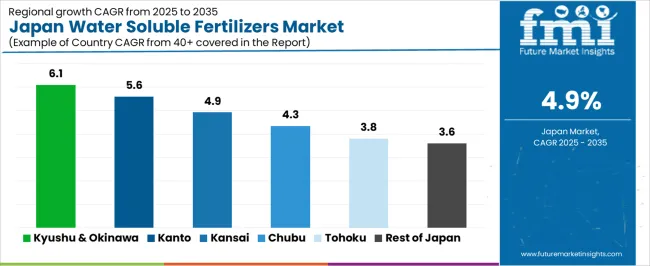
| Region | CAGR (%) |
|---|---|
| Kyushu & Okinawa | 6.1% |
| Kanto | 5.6% |
| Kinki | 4.9% |
| Chubu | 4.3% |
| Tohoku | 3.8% |
| Rest of Japan | 3.6% |
Demand for water soluble fertilizers in Japan is rising across regions, with Kyushu and Okinawa leading at 6.1%. Growth in this region reflects active horticulture and greenhouse cultivation, where soluble nutrients support efficient crop management. Kanto follows at 5.6%, supported by diverse agricultural activities and steady adoption of controlled nutrient delivery systems among commercial growers. Kinki records 4.9%, shaped by mixed farming patterns and expanding use of soluble fertilizers in specialty crop production. Chubu grows at 4.3%, influenced by regional fruit and vegetable cultivation. Tohoku reaches 3.8% as farmers adopt precision-oriented practices. The rest of Japan posts 3.6%, indicating gradual uptake across smaller agricultural zones.
Kyushu & Okinawa is projected to grow at a CAGR of 6.1% through 2035 in demand for water soluble fertilizers. Fukuoka and surrounding agricultural regions are increasingly adopting these fertilizers for fruit, vegetable, and ornamental crop production. Rising focus on crop yield optimization, nutrient efficiency, and soil management drives adoption. Manufacturers provide fertilizers compatible with drip, foliar, and fertigation systems. Distributors ensure accessibility across urban, semi-urban, and rural farms. Growth in horticulture, intensive farming, and greenhouse cultivation supports steady adoption of water soluble fertilizers in Kyushu & Okinawa.
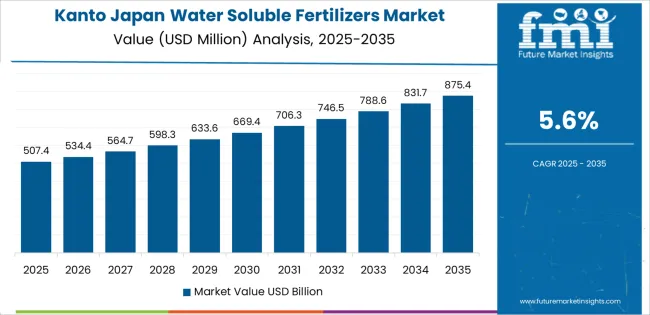
Kanto is projected to grow at a CAGR of 5.6% through 2035 in demand for water soluble fertilizers. Tokyo and neighboring prefectures are increasingly adopting these fertilizers for vegetables, flowers, and greenhouse crops. Rising focus on improved crop yield, nutrient management, and sustainable farming practices drives adoption. Manufacturers supply fertilizers suitable for fertigation, drip irrigation, and foliar applications. Distributors ensure availability across urban, semi-urban, and rural agricultural regions. Expansion in horticulture, greenhouse cultivation, and high-value crop production supports steady adoption of water soluble fertilizers across Kanto.
Kinki is projected to grow at a CAGR of 4.9% through 2035 in demand for water soluble fertilizers. Osaka, Kyoto, and surrounding areas are gradually adopting these fertilizers for vegetables, flowers, and greenhouse horticulture. Rising demand for improved nutrient efficiency, higher yields, and precise soil management drives adoption. Manufacturers provide fertilizers compatible with drip irrigation, fertigation, and foliar feeding systems. Distributors ensure accessibility across urban and semi-urban farms. Expansion in greenhouse cultivation, intensive horticulture, and high-value crop production supports steady adoption of water soluble fertilizers across Kinki.
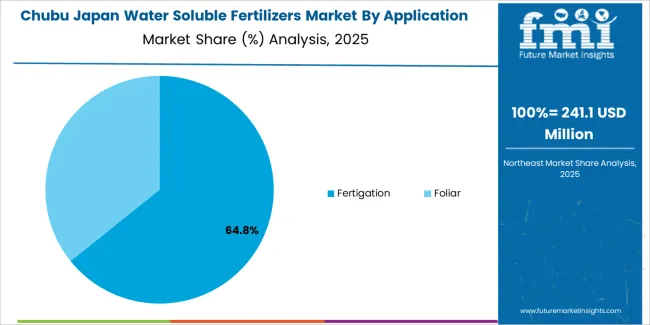
Chubu is projected to grow at a CAGR of 4.3% through 2035 in demand for water soluble fertilizers. Nagoya and surrounding areas are increasingly adopting these fertilizers for vegetable, fruit, and greenhouse cultivation. Rising focus on nutrient management, crop yield improvement, and precision farming drives adoption. Manufacturers supply fertilizers suitable for drip irrigation, foliar application, and fertigation systems. Distributors ensure accessibility across urban and semi-urban agricultural regions. Growth in intensive horticulture, greenhouse crop production, and high-value farming supports steady adoption of water soluble fertilizers across Chubu.
Tohoku is projected to grow at a CAGR of 3.8% through 2035 in demand for water soluble fertilizers. Sendai and surrounding regions are gradually adopting these fertilizers for vegetables, fruits, and greenhouse crops. Rising demand for higher yields, nutrient efficiency, and precision soil management drives adoption. Manufacturers provide fertilizers compatible with drip irrigation, fertigation, and foliar feeding. Distributors ensure accessibility across urban, semi-urban, and rural farms. Expansion in horticulture, greenhouse cultivation, and intensive farming supports steady adoption of water soluble fertilizers across Tohoku.
How Is Rest of Japan Supporting Demand for Water Soluble Fertilizers?
The Rest of Japan is projected to grow at a CAGR of 3.6% through 2035 in demand for water soluble fertilizers. Smaller towns and rural areas gradually adopt these fertilizers for vegetables, fruits, and greenhouse crops. Rising focus on nutrient management, soil efficiency, and crop productivity drives adoption. Manufacturers supply fertilizers suitable for fertigation, foliar, and drip irrigation systems. Distributors ensure accessibility across urban, semi-urban, and rural farms. Expansion in horticulture, intensive agriculture, and greenhouse crop production supports steady adoption of water soluble fertilizers across the Rest of Japan.
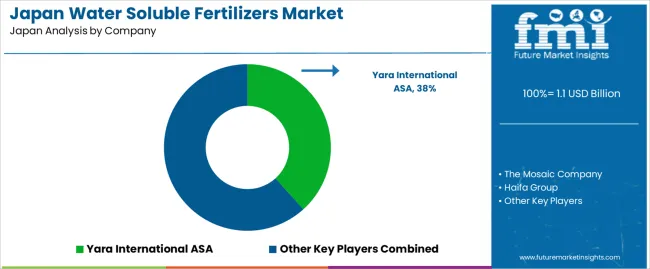
The demand for water soluble fertilizers in Japan is increasing as growers aim to improve nutrient efficiency, crop quality and yield within limited farmland. Japan relies heavily on controlled-environment agriculture, where greenhouse vegetables, hydroponic systems and intensive horticulture require fertilizers that dissolve quickly and deliver precise nutrient ratios. Water soluble formulations integrate easily with fertigation equipment, allowing growers to adjust nutrient supply according to crop stage and environmental conditions. Their use supports consistent quality for high-value fruits and vegetables, which are central to Japan’s domestic market and export channels. With growing attention to nutrient runoff reduction and resource-efficient farming, water soluble fertilizers have become essential for balancing productivity and environmental expectations across Japan’s agricultural sector.
Key players shaping Japan’s water soluble fertilizer segment include a blend of global suppliers and active regional participants. Yara International ASA, The Mosaic Company, Haifa Group and ICL Group provide nutrient formulations suited to fertigation and greenhouse systems commonly used in Japan. Their portfolios include specialized NPK blends, micronutrients and crop-specific solutions aligned with Japanese cultivation standards. Alongside these firms, domestic distributors and formulations specialists support localized supply, packaging and advisory services for growers. This mix of international producers and national players ensures product availability, technical guidance and alignment with Japan’s evolving agricultural practices. Together, they influence how water soluble fertilizers are selected, tailored and applied across diverse production settings in Japan.
| Items | Values |
|---|---|
| Quantitative Units (2025) | USD billion |
| Product Type | Nitrogenous, Phosphate-based, Potassium-based, N.P Complex, Sulfur, Micronutrients |
| Application | Fertigation, Foliar |
| Crop Type | Cereals & Pulses, Horticulture, Lawn, Turf & Ornamental, Others |
| Region | Kyushu & Okinawa, Kanto, Kinki, Chubu, Tohoku, Rest of Japan |
| Countries Covered | Japan |
| Key Companies Profiled | Yara International ASA, The Mosaic Company, Haifa Group, ICL Group, domestic distributors and formulation specialists |
| Additional Attributes | Dollar by sales by product type, application, and crop type; regional CAGR and adoption trends; volume vs. value contribution over forecast period; growth in precision fertigation, greenhouse, and controlled-environment agriculture; projected increase to USD 1.7 billion by 2035; integration with drip, foliar, and fertigation systems; adoption across horticulture, high-value crops, and specialty greenhouse production; challenges include cost, infrastructure investment, and compliance with water-quality regulations; opportunities in automated and IoT-enabled nutrient systems. |
The demand for water soluble fertilizers in japan is estimated to be valued at USD 1.1 billion in 2025.
The market size for the water soluble fertilizers in japan is projected to reach USD 1.8 billion by 2035.
The demand for water soluble fertilizers in japan is expected to grow at a 4.9% CAGR between 2025 and 2035.
The key product types in water soluble fertilizers in japan are nitrogenous, phosphate-based, potassium-based, n.p complex, sulfur and micronutrients.
In terms of application, fertigation segment is expected to command 63.9% share in the water soluble fertilizers in japan in 2025.






Our Research Products

The "Full Research Suite" delivers actionable market intel, deep dives on markets or technologies, so clients act faster, cut risk, and unlock growth.

The Leaderboard benchmarks and ranks top vendors, classifying them as Established Leaders, Leading Challengers, or Disruptors & Challengers.

Locates where complements amplify value and substitutes erode it, forecasting net impact by horizon

We deliver granular, decision-grade intel: market sizing, 5-year forecasts, pricing, adoption, usage, revenue, and operational KPIs—plus competitor tracking, regulation, and value chains—across 60 countries broadly.

Spot the shifts before they hit your P&L. We track inflection points, adoption curves, pricing moves, and ecosystem plays to show where demand is heading, why it is changing, and what to do next across high-growth markets and disruptive tech

Real-time reads of user behavior. We track shifting priorities, perceptions of today’s and next-gen services, and provider experience, then pace how fast tech moves from trial to adoption, blending buyer, consumer, and channel inputs with social signals (#WhySwitch, #UX).

Partner with our analyst team to build a custom report designed around your business priorities. From analysing market trends to assessing competitors or crafting bespoke datasets, we tailor insights to your needs.
Supplier Intelligence
Discovery & Profiling
Capacity & Footprint
Performance & Risk
Compliance & Governance
Commercial Readiness
Who Supplies Whom
Scorecards & Shortlists
Playbooks & Docs
Category Intelligence
Definition & Scope
Demand & Use Cases
Cost Drivers
Market Structure
Supply Chain Map
Trade & Policy
Operating Norms
Deliverables
Buyer Intelligence
Account Basics
Spend & Scope
Procurement Model
Vendor Requirements
Terms & Policies
Entry Strategy
Pain Points & Triggers
Outputs
Pricing Analysis
Benchmarks
Trends
Should-Cost
Indexation
Landed Cost
Commercial Terms
Deliverables
Brand Analysis
Positioning & Value Prop
Share & Presence
Customer Evidence
Go-to-Market
Digital & Reputation
Compliance & Trust
KPIs & Gaps
Outputs
Full Research Suite comprises of:
Market outlook & trends analysis
Interviews & case studies
Strategic recommendations
Vendor profiles & capabilities analysis
5-year forecasts
8 regions and 60+ country-level data splits
Market segment data splits
12 months of continuous data updates
DELIVERED AS:
PDF EXCEL ONLINE
Water Soluble Fertilizers Market Trends 2025 to 2035
Water Soluble Bag Market Size and Share Forecast Outlook 2025 to 2035
Water-soluble Packaging Market Size and Share Forecast Outlook 2025 to 2035
Water Soluble Pods and Capsules Packaging Market Size and Share Forecast Outlook 2025 to 2035
Water-Soluble Retinol Market Size and Share Forecast Outlook 2025 to 2035
Water Soluble Polymer Market Size and Share Forecast Outlook 2025 to 2035
Water Soluble Detergent Pods Market Size and Share Forecast Outlook 2025 to 2035
Water Soluble Pods Packaging Market Analysis by Material Type, Product Type, End Use, Thickness Type, and Region Forecast Through 2035
Key Companies & Market Share in the Water Soluble Detergent Pods Sector
Competitive Breakdown of Water-Soluble Packaging Companies
Water Soluble Vitamins Market
Water-Soluble Flavors Market
Water Pod Soluble Machines Market Size and Share Forecast Outlook 2025 to 2035
Japan Sea Water Pumps Market Report – Trends & Innovations 2025-2035
Cold Water Soluble Creamer Market Growth - Base & Function Trends
Demand for Cold Water Soluble Starch in EU Size and Share Forecast Outlook 2025 to 2035
Demand for Water Ionizer in Japan Size and Share Forecast Outlook 2025 to 2035
Demand for Water Testing Kit in Japan Size and Share Forecast Outlook 2025 to 2035
Demand for Water Treatment System in Japan Size and Share Forecast Outlook 2025 to 2035
Water Vapor Permeability Analyzers Market Size and Share Forecast Outlook 2025 to 2035

Thank you!
You will receive an email from our Business Development Manager. Please be sure to check your SPAM/JUNK folder too.
Chat With
MaRIA